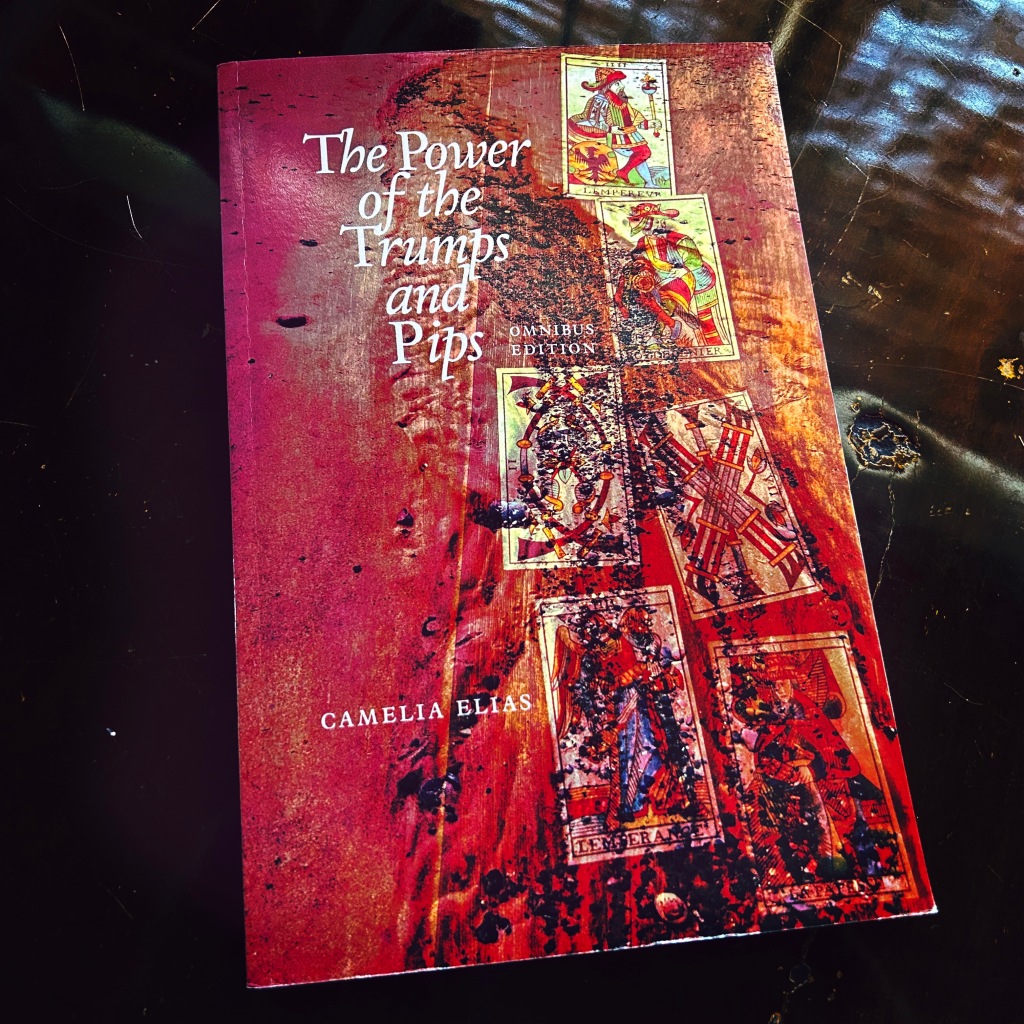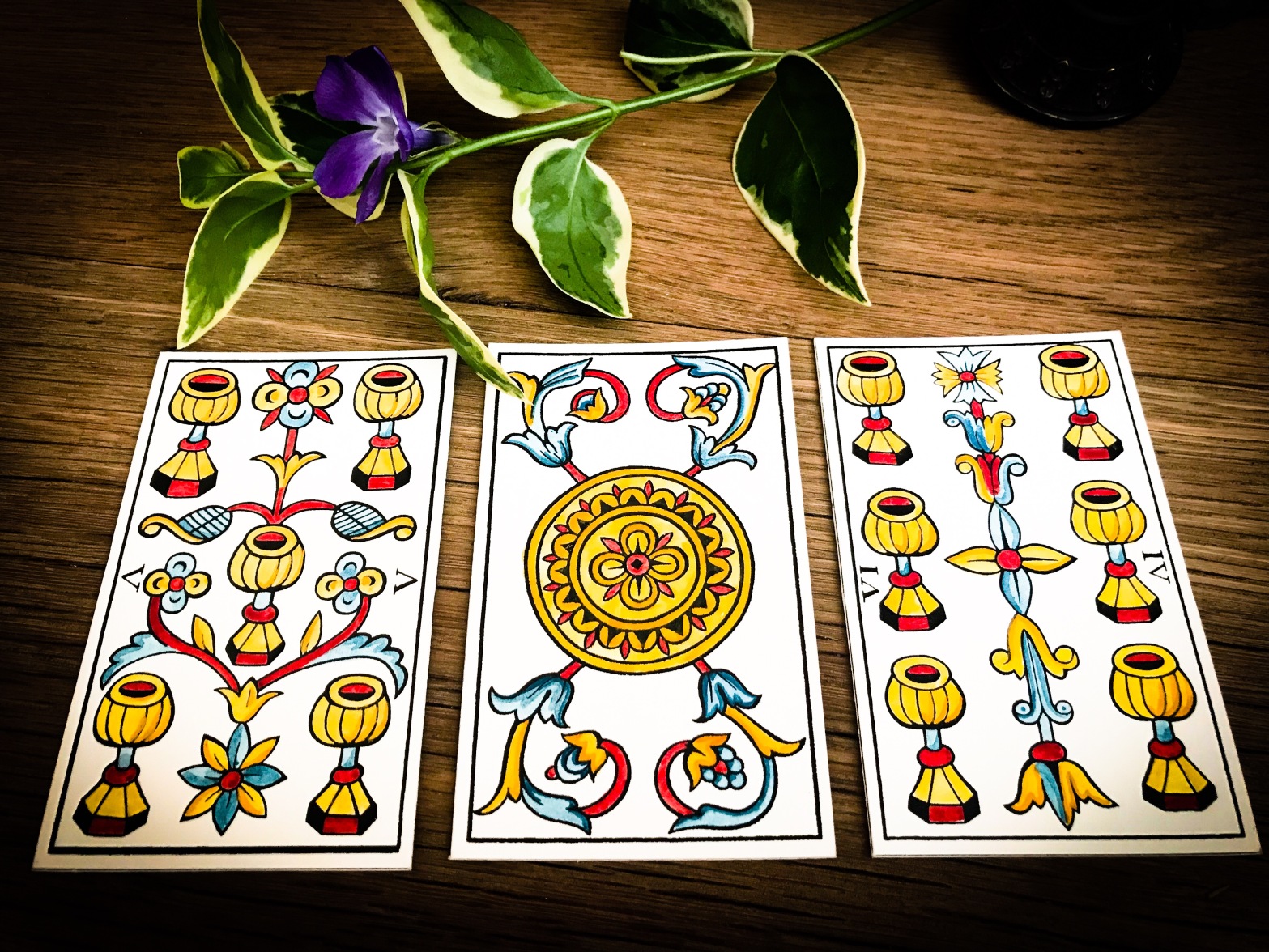It pleases me to see that more and more people are taking the pip cards of the Marseille Tarot to their hearts.
We can discuss my aspects of the formal composition of the pip cards, from content to color to line, and reflect on what to make of abstract design when we divine with the full deck.
Where the pip cards are concerned, we can debate how abstract the design really is, when it’s quite plain that not only can we distinguish between the representation of the 4 suits via negation – cups are not like batons, and coins are not like swords – but we can also make a lot of inferences as to the logical display of the foliage and ‘green matter’ that accompanies the 4 elements.
Today a tarot reader tagged me on Facebook in a discussion about the function of the foliage in the pip cards. While I’m not at liberty to refer to another person’s work in a context other than the one it was offered within, I can quote what I had to say, as some others here may find it useful.
I said the following:
The way I work with leaves on the pip cards when I teach and write about ‘function over symbol’ is by following a basic principle:
The leaves either divide or unite.
In a reading session, which one applies is entirely dependent on the context of the question and the distribution of the cards on the table.
On another level than observing the binary syntax, leaves fill empty space as a way towards displacing anxiety.
As a general rule people don’t like emptiness, but that’s where it’s at, as far as I’m concerned.
I work with awareness of binary oppositions and empty space when I read the pip cards, because it’s the most exciting.
So indeed, while we may point to both the abstract and the concrete representation of the seasons changing – with buds becoming flowers only to die and return to their roots – we can think of what these transformations do in terms of uniting or dividing.
As with all my work with the cards, what I’m looking for primarily is the Devil’s cut, that is to say, I want to peep into the pip’s heart, and thus get to the principle that underlies the idea of ‘flower’, ‘number’, or, ‘design.’
Unite or divide
In the example here, we have foliage forming a heart around a cup at the center of the first card. This one is special.
The Ace of Coins gathers the leaves at their roots, uniting them in the one coin. This one is also special
In the 6 of Cups we have division. To each their own. Some drink red wine and others white wine at a party. While they’re engaged in the same activity, rolling together with the good times, each row of cups minds its business.
Taken together we can say this:
What you love the most is where the landing value is. Roll with it, while keeping an eye on what the others are drinking.
♦
P.S After I wrote this post I immediately got an interesting question about the 5 of Cups in Aradia Academy Alumni, the Facebook group created for all who have taken any of my course.
The answer to the question sheds more light on where I come from to the idea of uniting or diving, so I’ll upgrade it here for all to reflect on:
Dorian Broadway asks:
If I may ask – in the 5 of Cups, I was torn between seeing it as unity (the foliage reaches out to all the cups) and division (the cups are each kept apart by the foliage). Are some cards able to go both ways while others are more clearly one or the other, context depending?
I answer:
Jut think: I said the heart. What do you know of the heart? Anatomically speaking it sits in the middle of our body, uniting all sorts of stuff.
The fact that the Five of Cups creates a heart at the center of everything, instantly sends us to making an inference based on memory, and as always, we need memory as it’s our only semantics machine.
So yes, the idea of uniting or dividing still rests on what we see. The more we see the obvious the better the interpretation.
If you see the leaves going both ways, uniting and dividing, you must look into what creates the paradox in your mind, for the answer is there. Anything else would be yet another ‘meaning’ from a forgotten little white book.
When that is said, speaking of anatomy, we have a tendency to see harmony in anything that resembles our own body, that’s why a tree that looks like us is able to move our hearts more than a tree that goes in all directions. The best designers learnt this principle, and you can observe it in their art.
Card makers are no exception. They created the foliage in order to appeal to our familiarity with the body, or indeed, when needed, they created what Freud called, ‘das unbehagen’, or a feeling of horror and unease.
♠
For more such practice with the cards:
- Join the Read like the Devil Club.
- Visit also Aradia Academy and sign up for the newsletter that will keep you informed on upcoming courses and cartomantic activities. Note the Off the Shelf offering that also includes free resources.
- Check out my books on the philosophy and practice of divination at EyeCorner Press.
- Get a reading. When I perform a reading, I also teach, simply because I can’t help myself, so you will be twice served.



